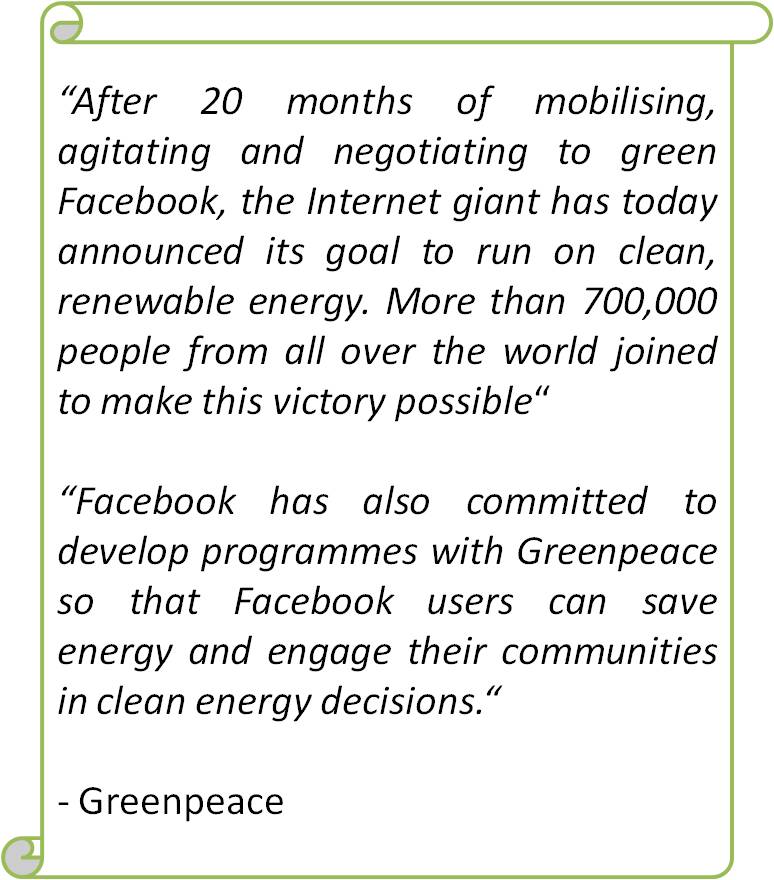Greenpeace persuades facebook to win battle against coal
“Victory! Facebook ‘friends’ renewable energy” is the roaring headline in news on the Greenpeace website on Dec 15th, 2011. Finally the focused non-governmental environmental organization working in the field of environment management and climate change –Greenpeace successfully convinced the social media giant Facebook to shift to renewable energy for their upcoming data centers. Facebook has more than 800 million active users (July 2011) and now accounts for 9% of all internet traffic in the US alone.
 Greenpeace stated on its website that Facebook has agreed that it will give preference to renewable energy to power their data centers in the future, will collaborate with Greenpeace to promote renewable energy, will encourage major utilities to develop renewable energy generation, will develop programmes that will enable Facebook users to save energy and will engage their communities in clean energy decisions.
Greenpeace stated on its website that Facebook has agreed that it will give preference to renewable energy to power their data centers in the future, will collaborate with Greenpeace to promote renewable energy, will encourage major utilities to develop renewable energy generation, will develop programmes that will enable Facebook users to save energy and will engage their communities in clean energy decisions.
As per the report – “Smart 2020: Enabling the low carbon economy in the information age” by The Climate Group, the entire information and communication technologies or ICT sector was estimated to be responsible for roughly 2% of global carbon emissions (2007). Data centers have 14% of the share in overall ICT carbon footprint.
What are data centers?
A data center is a centralized repository for the storage, management, and dissemination of data and information. Data centers can include several servers (Servers are the computers or devices on a network that manages network resources).
What is the relation between energy and data centers?
Data centres allow large storage facilities and computing power and hence these are one of the fastest growing power consuming segments. Energy use is a central issue for data centers. Data centers are voracious in terms of energy requirement. Mostly power requirement lies in central equipments of the data centres like series of servers and the second top most requirements is cooling. Electricity is the back bone of data centers and its electricity requirement lies from few KW to thousands of MW. In addition, larger data centers have a higher power density and correspondingly higher electricity costs. Hence, the cost of power is dominant operating expense in running of these facilities. Electricity costs account for over 10% of the total cost of establishment of data centers.
Data centers are sensitive to heat and heat itself is a by-product of each component of data centers. This heat can cause electronic equipment malfunction; therefore the physical environment of a data center is rigorously controlled by air conditioning systems to control the temperature and humidity in the data center. The American Society of Heating, Refrigerating and Air Conditioning Engineers (ASHRAE) have given ‘Thermal Guidelines for Data Processing Environments’ for the modern data centers. These guidelines recommends a temperature range of 16–24 °C and humidity range of 40–55% with a maximum dew point of 15 °C as optimal for data center conditions. ASHRAE is an international technical society for all individuals and organizations interested in heating, ventilation, air-conditioning, and refrigeration.
For more information, please visit Greenpeace website here
Featured image credit: http://en.wikipedia.org/wiki/File:Facebook.svg

